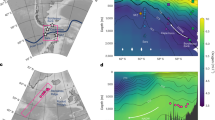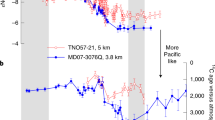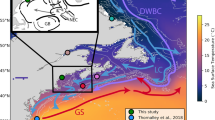Abstract
The concentration of radiocarbon, 14C, in the atmosphere depends on its production rate by cosmic rays, and on the intensity of carbon exchange between the atmosphere and other reservoirs, for example the deep oceans. For the Holocene (the past ∼11,500 years), it has been shown that fluctuations in atmospheric radiocarbon concentrations have been caused mostly by variations in the solar magnetic field1,2,3. Recent progress in extending the radiocarbon record backwards in time4,5,6,7,8,9,10 has indicated especially high atmospheric radiocarbon concentrations in the Younger Dryas cold period, between 12,700 and 11,500 years before the present. These high concentrations have been interpreted as a result of a reduced exchange with the deep-ocean reservoir, caused by a drastic weakening of the deep-ocean ventilation7,8,9,11,12. Here we present a high-resolution reconstruction of atmospheric radiocarbon concentrations, derived from annually laminated sediments of two Polish lakes, Lake Gościa̧ż and Lake Perespilno. These records indicate that the maximum in atmospheric radiocarbon concentrations in the early Younger Dryas was smaller than previously believed, and might have been caused by variations in solar activity. If so, there is no indication that the deep-ocean ventilation in the Younger Dryas was significantly different from today’s.
This is a preview of subscription content, access via your institution
Access options
Subscribe to this journal
Receive 51 print issues and online access
$199.00 per year
only $3.90 per issue
Buy this article
- Purchase on Springer Link
- Instant access to full article PDF
Prices may be subject to local taxes which are calculated during checkout



Similar content being viewed by others
References
Stuiver, M. & Quay, P. D. Changes in atmospheric carbon-14 attributed to a variable Sun. Science 207, 11–19 (1980).
Beer, J. et al. Information on past solar activity and geomagnetism from 10Be in the Camp Century ice core. Nature 331 , 675–679 (1988).
Bard, E., Raisbeck, G. M., Yiou, F. & Jouzel, J. Solar modulation of cosmogenic nuclide production over the last millennium: comparison between 14C and 10Be records. Earth Planet. Sci. Lett. 150, 453–462 ( 1997).
Bard, E. Geochemical and geophysical implications of the radiocarbon calibration. Geochim. Cosmochim. Acta 62, 2025–2038 (1998).
Bard, E. et al. Deglacial sea-level record from Tahiti corals and the timing of global meltwater discharge. Nature 382, 241–244 (1996).
Edwards, R. L. et al. A large drop in atmospheric 14C/12C and reduced melting in the Younger Dryas, documented with 230Th ages of corals. Science 260, 962– 968 (1993).
Goslar, T. et al. High concentration of atmospheric 14C during the Younger Dryas cold episode. Nature 377, 414–417 (1995).
Goslar, T. et al. Variations of atmospheric 14C concentrations over the Alleröd-Younger Dryas transition. Clim. Dyn. 15, 29–42 (1999).
Hughen, K. A. et al. Deglacial changes in ocean circulation from an extended radiocarbon calibration. Nature 391, 65– 68 (1998).
Kitagawa, H. & van der Plicht, J. Atmospheric radiocarbon calibration to 45,000 yr B. P.: late glacial fluctuations and cosmogenic isotope production. Science 279, 1187–1190 (1998).
Björck, S. et al. Synchronised terrestrial-atmospheric deglacial records around the North Atlantic. Science 274, 1155– 1160 (1996).
Stocker, T. F. & Wright, D. G. Rapid changes in ocean circulation and atmospheric radiocarbon. Paleoceanography 11, 773–795 (1996).
Goslar, T. et al. Climate-related variations in the composition of the late glacial and early Holocene sediments of Lake Perespilno (eastern Poland). Quat. Sci. Rev. 18, 899–911 (1999).
Stuiver, M. et al. INTCAL98 Radiocarbon age calibration, 24,000-0 cal BP. Radiocarbon 40, 1041–1083 (1998).
Spurk, M. et al. Revisions and extension of the Hohenheim oak and pine chronologies: new evidence about the timing of the Younger Dryas/Preboreal transition. Radiocarbon 40, 1107–1116 (1998).
Bard, E., Hamelin, B., Fairbanks, R. G. & Zindler, A. Calibration of the 14C timescale over the past 30,000 years using mass spectrometric U-Th ages from Barbados corals. Nature 345, 405–410 ( 1990).
Johnsen, S. J. et al. Irregular glacial interstadials recorded in a new Greenland ice core. Nature 359, 311– 313 (1992).
Hammer, C. U. et al. The Stratigraphic Dating of the GRIP Ice Core. (Special Report of the Geophysics Department, Inst. Niels Bohr for Astronomy, Physics and Geophysics, Univ. Copenhagen, 1998).
Alley, R. B. et al. Abrupt increase in Greenland snow accumulation at the end of the Younger Dryas event. Nature 362, 527–529 (1993).
Brauer, A. et al. High resolution sediment and vegetation responses to Younger Dryas climate change in varved lake sediments from Meerfelder Maar, Germany. Quat. Sci. Rev. 18, 321– 329 (1999).
Finkel, R. C. & Nishiizumi, K. Beryllium 10 concentrations in the Greenland Ice Sheet Project 2 ice core from 3-40 ka. J. Geophys. Res. 102, 26699–26706 ( 1997).
Broecker, W. S. Paleocean circulation during the last deglaciation: A bipolar seesaw? Paleoceanography 13, 119–121 (1998).
Blunier, T. et al. Timing of the Atlantic cold reversal and the atmospheric CO 2 increase with respect to the Younger Dryas event. Geophys. Res. Lett. 24, 2683–2686 (1997).
Alley, R. B. et al. Changes in continental and sea-salt atmospheric loadings in central Greenland during the most recent deglaciation: Model-based estimates. J. Glaciology 41, 503– 514 (1995).
Mikolajewicz, U. A Meltwater Induced Collapse of the “Conveyor Belt” Thermohaline Circulation and its Influence on the Distribution of Δ14C and δ18O in the Oceans (Technical Report 189, Max-Planck-Inst. für Meteorologie, Hamburg, 1996).
Goslar, T. et al. High-resolution lacustrine record of the Late Glacial/Holocene transition in Central Europe. Quat. Sci. Rev. 12, 287–294 (1993).
Broecker, W. S. et al. The distribution of radiocarbon in the Glacial Ocean. Glob. Biogeochem. Cycles 4, 103–117 (1990).
Acknowledgements
We thank R. Finkel for the numerical data on 10Be concentration in the GISP2 ice core, R. Alley for the data on the GISP2 accumulation rate, K. Hughen for the 14C calibration data and the grey-scale record of the Cariaco sediments, S. Johnsen and C. Hammer for the data on the GRIP timescale, M. Spurk for the data on the German pine tree-ring thickness, and E. Bard for comments on the manuscript. The sediment cores from Lake Gościa̧ż and Lake Perspilno were raised with the help of J. Pawlyta, A. Rakowski and A. Walanus. The terrestrial macrofossils were picked up by D. Moszyńska-Moskwa. The French Centre National de la Recherche Scientifique et Commissariat de l’Energie Atomique carried out accelerator mass spectrometer (AMS) 14C measurements. This work has been sponsored by the Polish Committee for Scientific Research, through the grant to T.G.
Author information
Authors and Affiliations
Corresponding author
Supplementary Information
Rights and permissions
About this article
Cite this article
Goslar, T., Arnold, M., Tisnerat-Laborde, N. et al. Variations of Younger Dryas atmospheric radiocarbon explicable without ocean circulation changes. Nature 403, 877–880 (2000). https://doi.org/10.1038/35002547
Received:
Accepted:
Issue Date:
DOI: https://doi.org/10.1038/35002547
This article is cited by
-
Volcanoes and climate: the triggering of preboreal Jökulhlaups in Iceland
International Journal of Earth Sciences (2020)
-
Would North American Paleoindians have Noticed Younger Dryas Age Climate Changes?
Journal of World Prehistory (2010)
-
Tree rings and ice cores reveal 14C calibration uncertainties during the Younger Dryas
Nature Geoscience (2008)
-
Timing of the late glacial and Younger Dryas cold reversal in southern Chile varved sediments
Journal of Paleolimnology (2008)
-
The Allerød/Younger Dryas transition in Wolin Island, northwest Poland, as reflected by pollen, macrofossils, and chemical content of an organic layer separating two aeolian series
Vegetation History and Archaeobotany (2006)
Comments
By submitting a comment you agree to abide by our Terms and Community Guidelines. If you find something abusive or that does not comply with our terms or guidelines please flag it as inappropriate.



